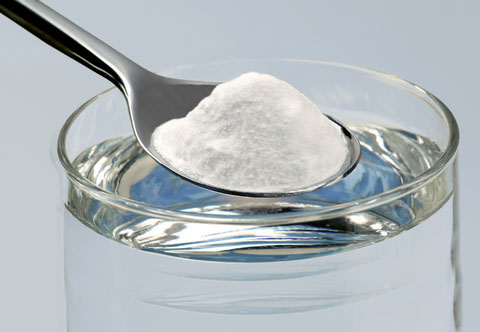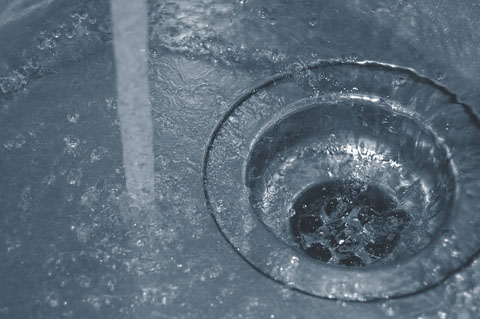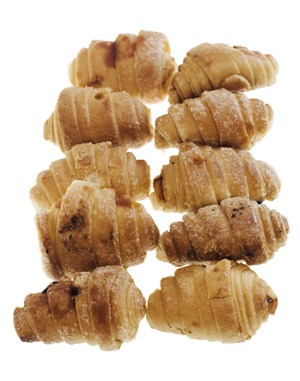What is baking soda?

What is that powdery white stuff you add to your dough? Baking soda, which is what causes your dough and batter to rise, is... salt.
Chemically, baking soda is NaHCO3. Nahcolite, another name for baking soda, is a reference to this chemical formula. It is also called thermokalite.
Baking soda is a mildly alkaline mineral. It has a pH of 8.1; pH 7 is neutral. What makes it so useful is its ability to maintain its pH. When acids (which lower pH) or bases (which raise it) are added to baking soda, it tends to maintain a 8.1 pH. This is what provides baking soda’s ability to neutralize odors.
Chemists refer to baking soda as:
- sodium bicarbonate
- bicarbonate of soda
- bicarb
- sodium hydrogen carbonate
- sodium acid carbonate

Baking soda can be found in natural mineral deposits. It was first manufactured in the 1790’s by a French chemist named Nicolas Leblanc. Today it is commercially made by using the Solvay method: carbon dioxide and ammonia are passed through a concentrated solution of sodium chloride. The result is crude sodium bicarbonate, which is heated to form soda ash. The soda ash is then refined to meet purity standards.
Put the baking in Baking Soda
When baking soda meets an acidic ingredient like lemon juice, a chemical reaction takes place. The visible reaction is the release of carbon dioxide. At temperatures above 300°, say in your oven, baking soda will decompose into sodium carbonate, water, and of course carbon dioxide.
The result? Lots of bubbles. The expanding gas inside the dough creates leavening. This is why your dough rises.
The best way to store baking soda is to keep it in the standard cool, dry place. Keep the lid on to prevent exposure to the air.
Baking soda will last on the shelf for 18 months. If you are not sure if it is fresh, try this test:
- Put 1/2 teaspoon of baking soda in a shallow dish
- Pour a few drops of lemon juice or vinegar on top
- If you see vigorous bubbles, it is ready to use!
You'll be humming this tune all day...
Harness the power of the science experiment volcano
Vinegar, an acid, is particularly good at triggering the onslaught of a foamy baking soda eruption.
Imagine if this tiny storm in a teacup was instead a tiny storm in your sink drain.
Slow running drains are perfect for playing science experiment volcano.
Put 1/4 cup of baking soda down the drain. For extra scrubbing power, add some kosher salt. Next, pour in 1 cup of vinegar.
Cover the drain and wait fifteen minutes for the storm to subside. Follow by rinsing the drain with very hot or boiling water.

Note: salt is very corrosive.
If you use it, be sure to run water through the drain for ten to fifteen minutes to be sure the salt is washed out of your pipes.
Keep things neutral
An open box of baking soda in your refrigerator will neutralize odor. Along with odor it will absorb moisture, which can form a crust on the top of the baking soda. Keep it fresh for optimum results. Sprinkle baking soda in the vegetable crisper and cover with paper towels. Don’t forget your freezer too!
Fishy odor is obviously not as strong as spoiled fish odor. If your leftovers get the better of you, you’ll need clean the fridge out. After the bad food is gone, wash the inside walls with baking soda and warm water. For surface stains inside and out, make a paste of baking soda and water.
Sprinkle baking soda on your carpet, upholstery and rugs – in your home and your car. Wait 15 minutes for it to absorb odor, and then vacuum it out. Check first for color fastness by mixing 1/2 cup of water with about 1/2 teaspoon of baking soda. Put a small amount of your test mix in a hidden spot. Let it dry, then vacuum and see if there was damage to the color.

How to substitute baking soda
Say your baking soda failed the freshness test, or you simply ran out. You need those bubbles to make your cake rise! Don’t worry, you can substitute.
Grab your baking powder. Although it contains contains sodium bicarbonate, it also has cream of tartar and a small amount of starch, a drying agent. Because it contains extra ingredients, you will need to use a larger quantity when you substitute it for baking soda. It will also have a mild effect on flavor.
For straight substitution, use a three to one ratio. That is, three tablespoons of baking powder instead of one tablespoon of baking soda for example.
My chef friend goes one step further: to control the mild effect this will have on flavor, she uses a two to one ratio of baking powder to baking soda. She then leaves the salt out of the recipe.
Of course, you can use baking soda to make your own baking powder as well. Simply mix one teaspoon of baking soda with two teaspoons of cream of tartar.
One more use...
Remember, when you heat baking soda, it will release carbon dioxide and water. Carbon dioxide is heavier than oxygen.
Therefore, if you dump baking soda on a fire, the heat will react with it to create the elements you need to put the fire out.
If you have a kitchen fire, grab the baking soda!
© 2009 wyanjen at HubPages
Baking Soda: refined and defined








